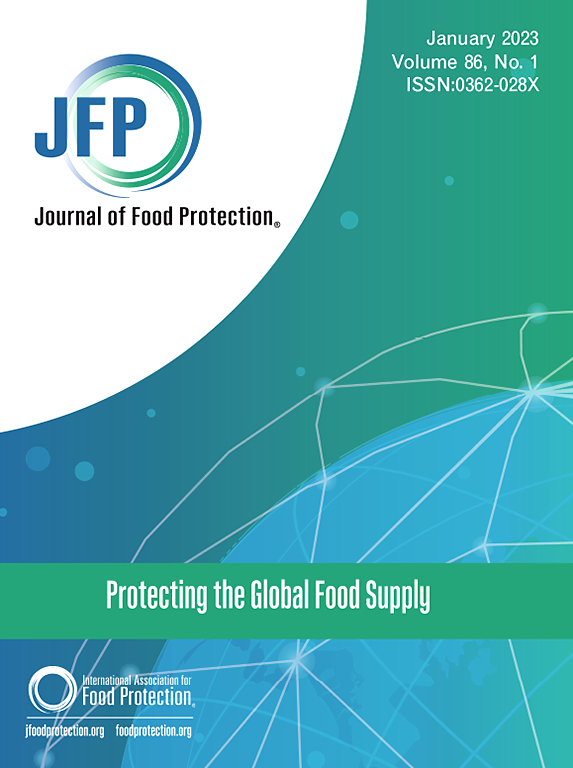Effects of a Novel Direct-fed Microbial on Occurrences of Antimicrobial Resistance in Salmonella enterica, Escherichia coli, and Enterococcus spp. Measured Longitudinally From Feedlot Arrival to Harvest in Finishing Beef Steers
IF 2.1
4区 农林科学
Q3 BIOTECHNOLOGY & APPLIED MICROBIOLOGY
引用次数: 0
Abstract
Before implementation of the Veterinary Feed Directive in 2017, medically important antimicrobials, like tylosin, were approved for both therapeutic and subtherapeutic use. Nevertheless, subtherapeutic practices are now considered injudicious because their use increases antimicrobial resistance risk. Therefore, heightened consumer concerns have increased the interest in antimicrobial alternatives like direct-fed microbials. Two-hundred forty Angus beef steers (mean initial BW = 263 kg ± 18.0 kg) were assigned randomly to one of three dietary treatments; negative control, dietary supplement contained no tylosin (NCON); positive control, dietary supplement contained tylosin (PCON); or novel direct-fed microbial fed at 1 g mixture/steer with 1 × 1011 CFU/g (DFM). Fecal samples were collected on days 0, 59, 128, and at study end. Pen and hide swabs were collected two days before harvest, and subiliac lymph nodes were collected on the day of harvest. All targeted bacterial populations differed across time (p ≤ 0.05), except 128ERYR Escherichia coli. Fecal Salmonella concentration and prevalence differed among dietary treatments (p = 0.02) with NCON having greater fecal Salmonella concentrations than PCON and DFM. No differences in Salmonella prevalence among pen swabs, hide swabs, or subiliac lymph nodes were detected (p ≥ 0.40). Salmonella resistant to tetracycline or cefotaxime were not detected in feces. The effect of treatment differed by day for total and 128ERYR Enterococcus spp. concentrations. Total Enterococcus spp. concentrations were greatest for the DFM treatment on day 128 and at study end (p ≤ 0.01). At study end, 128ERYR Enterococcus spp. concentrations were greatest for PCON (p ≤ 0.01). Total, TETR, COTR, and CTXR E. coli concentrations increased from d 0 to study end among treatments (p ≤ 0.01). These data suggest that the in-feed inclusion of a novel direct-fed microbial is not directly implicated in the antimicrobial resistance of feedlot beef cattle.
一种新型直接饲养微生物对肠沙门氏菌、大肠杆菌和肠球菌耐药性的影响。从饲养场到收获肥育肉牛纵向测量。
在2017年实施《兽医饲料指令》之前,泰络素等医学上重要的抗微生物药物已被批准用于治疗和亚治疗用途。然而,亚治疗做法现在被认为是不明智的,因为它们的使用增加了抗微生物药物耐药性的风险。因此,消费者的高度关注增加了对直接喂养微生物等抗菌替代品的兴趣。240头安格斯肉牛(平均初始体重= 263 kg±18.0 kg)被随机分配到三种饲粮处理中;阴性对照,膳食补充剂中不含泰洛菌素(NCON);阳性对照,膳食补充剂中含有泰络素(PCON);或以1 × 1011 CFU/g (DFM)饲喂1 g混合物/头的新型直接饲喂微生物。在第0、59、128天和研究结束时收集粪便样本。采集前2天采集笔拭子和皮拭子,采集当天采集髂骨下淋巴结。除128erycherichia coli外,所有目标菌群均存在时间差异(p≤0.05)。不同饲粮处理的粪便沙门氏菌浓度和患病率存在差异(p= 0.02),其中NCON的粪便沙门氏菌浓度高于PCON和DFM。笔拭子、皮拭子和髂下淋巴结的沙门氏菌患病率无差异(p≥0.40)。粪便中未检出对四环素或头孢噻肟耐药的沙门氏菌。处理对总浓度和128ERYREnterococcus spp.浓度的影响因天而异。DFM处理的总肠球菌浓度在第128天和研究结束时最高(p≤0.01)。研究结束时,PCON的浓度最高的是128ERYREnterococcus spp (p≤0.01)。Total, TETR, COTR和CTXRE。各处理的大肠杆菌浓度从第0天到研究结束均呈上升趋势(p≤0.01)。这些数据表明,在饲料中加入一种新型直接饲养的微生物与饲养场肉牛的抗菌素耐药性没有直接关系。
本文章由计算机程序翻译,如有差异,请以英文原文为准。
求助全文
约1分钟内获得全文
求助全文
来源期刊

Journal of food protection
工程技术-生物工程与应用微生物
CiteScore
4.20
自引率
5.00%
发文量
296
审稿时长
2.5 months
期刊介绍:
The Journal of Food Protection® (JFP) is an international, monthly scientific journal in the English language published by the International Association for Food Protection (IAFP). JFP publishes research and review articles on all aspects of food protection and safety. Major emphases of JFP are placed on studies dealing with:
Tracking, detecting (including traditional, molecular, and real-time), inactivating, and controlling food-related hazards, including microorganisms (including antibiotic resistance), microbial (mycotoxins, seafood toxins) and non-microbial toxins (heavy metals, pesticides, veterinary drug residues, migrants from food packaging, and processing contaminants), allergens and pests (insects, rodents) in human food, pet food and animal feed throughout the food chain;
Microbiological food quality and traditional/novel methods to assay microbiological food quality;
Prevention of food-related hazards and food spoilage through food preservatives and thermal/non-thermal processes, including process validation;
Food fermentations and food-related probiotics;
Safe food handling practices during pre-harvest, harvest, post-harvest, distribution and consumption, including food safety education for retailers, foodservice, and consumers;
Risk assessments for food-related hazards;
Economic impact of food-related hazards, foodborne illness, food loss, food spoilage, and adulterated foods;
Food fraud, food authentication, food defense, and foodborne disease outbreak investigations.
 求助内容:
求助内容: 应助结果提醒方式:
应助结果提醒方式:


